NCERT Exemplar Class 11 Biology Solutions Chapter 10 Cell Cycle and Cell Division
The NCERT Exemplar Class 11 Biology Solutions Chapter 10 Cell Cycle and Cell Division describes the process by which all living organisms develop and grow. Organisms begin life as a single cell, with new cells emerging from existing cells through cell division. This chapter explains topics such as DNA replication, cell cycle stages, and both mitosis and meiosis. The NCERT Exemplar contains different types of questions to check students' understanding and prepare them effectively for exams.
This Story also Contains
- Detailed Answers to Cell Cycle and Cell Division Class 11 NCERT Exemplar (MCQs)
- Access Answers to NCERT Exemplar Class 11 Biology Solutions Chapter 10 (Very Short Answer)
- Find Answers to NCERT Exemplar Class 11 Biology Chapter 10 (Short Answer)
- Get Answers to NCERT Exemplar Class 11 Biology Solutions Chapter 10 (Long Answer)
- Approach to Solve Cell Cycle and Cell Division Class 11 NCERT Exemplar
- Important topics of NCERT Exemplar Class 11 Biology Solutions Chapter 10
- Advantages of NCERT Exemplar Class 11 Biology Chapter 10 Solutions
- Important Questions of Cell Cycle and Cell Division Class 11 NCERT Exemplar
- NCERT Exemplar Class 11 Biology Solutions Chapter Wise

The Cell Cycle and Cell Division Class 11 NCERT Exemplar is designed by teachers to help students get a better hold on the chapter. Well-labelled diagrams and important terms are highlighted. How mitosis and meiosis differ from one another and why these processes are important are also covered. Practising the NCERT Exemplar Class 11 Biology Solutions Chapter 10, students can get a stronger hold and score well in their board and competitive exams. It also improves the speed, accuracy, and problem-solving skills of students.
Detailed Answers to Cell Cycle and Cell Division Class 11 NCERT Exemplar (MCQs)
Different forms of questions, like MCQs, short answers, and long answers with the required diagrams, are provided below. Practising the NCERT Exemplar Class 11 Biology Chapter 10 will help you understand the pattern and these concepts easily and effectively.
Question:1
Meiosis in diploid organisms results in
(a) Production of gametes
(b) Reduction in the number of chromosomes
(c) All of the above
(d) Introduction of variation
Answer:
The answer is option (c) All of the above
Explanation: Meiosis results in a reduction of the number of chromosomes, and gametes are formed only after meiosis. Crossing over during meiosis leads to variations. Hence, all the options are correct.
Question:2
At which stage of meiosis is the genetic constitution of gametes finally decided
(a) Metaphase I
(b) Anaphase I
(c) Metaphase II
(d) Anaphase II
Answer:
The answer is option (b), Anaphase I
Explanation: In anaphase I of meiosis, the actual reduction occurs, which decides the genetic constitution of the gamete. Every single homologous chromosome with its two chromatids and unsegregated centromere moves to the opposite poles of the cell.
Question:3
Meiosis occurs in organisms during
(a) Sexual reproduction
(b) Vegetative reproduction
(c) Both sexual and vegetative reproduction
(d) None of the above
Answer:
The answer is option (a) Sexual reproduction
Explanation: Option a is correct because there is no need for meiosis during vegetative reproduction.
Question:4
During anaphase I of meiosis
(a) Non-sister chromatids separate
(b) Non-homologous autosomes separate
(c) Sister chromatids separate
(d) Homologous chromosomes separate
Answer:
(d) Homologous chromosomes separate
Explanation: Homologous chromosomes are segregated during Anaphase I.
Question:5
Mitosis is characterised by
(a) Reduction division
(b) Both reduction and equal division
(c) Equal division
(d) Pairing of homologous chromosomes
Answer:
The answer is option (c) Equal division
Explanation: There is no reduction in chromosomes, and hence, mitosis is also called an equal division.
Question:6
A bivalent of meiosis I consists of
(a) Four chromatids and two centromeres
(b) Two chromatids and two centromeres
(c) Two chromatids and one centromere
(d) Four chromatids and four centromeres
Answer:
The answer is option (a): Four chromatids and two centromeres
Explanation: A bivalent is formed by the pairing of two homologous chromosomes, each with two chromatids, so it contains four chromatids and two centromeres.
Question:7
Cells that are not dividing are likely to be at
(a) G₁
(b) G₂
(c) S phase
(d) G₀
Answer:
The answer is option (d) G₀
Explanation: Phase G₀ is also called the quiescent phase, and no cell division takes place during this phase.
Question:8
Which of the events listed below is not observed during mitosis?
(a) Crossing over
(b) Movement of centrioles to opposite poles
(c) Appearance of chromosomes with two chromatids joined together at the centromere.
(d) Chromatin condensation
Answer:
The answer is option (a) Crossing over
Explanation: Crossing over takes place only during prophase I of meiosis.
Question:9
Identify the wrong statement about meiosis
(a) Pairing of homologous chromosomes
(b) Two cycles of DNA replication occur
(c) At the end of meiosis, the number of chromosomes is reduced to half
(d) Four haploid cells are formed
Answer:
The answer is option (b). Two cycles of DNA replication occur
Explanation: The number of chromosomes in daughter cells is half, so there is no need for another cycle of DNA replication.
Question:10
Select the correct statement about the G₁ phase
(a) The cell is metabolically inactive
(b) It is not a phase of the synthesis of macromolecules
(c) DNA in the cell does not replicate
(d) Cell stops growing
Answer:
The answer is option (c), DNA in the cell does not replicate
Explanation: The cell is metabolically active during the G₁ phase and continues to grow and carries out the synthesis of macromolecules, but DNA synthesis does not take place in this phase.
Access Answers to NCERT Exemplar Class 11 Biology Solutions Chapter 10 (Very Short Answer)
Question:1
Between a prokaryote and a eukaryote, which cell has a shorter cell division time?
Answer:
Prokaryote has a shorter division time.
Question:2
Which of the phases of the cell cycle is of the longest duration?
Answer:
Interphase is the longest phase of the cell cycle.
Question:3
Name a stain commonly used to colour chromosomes.
Answer:
Acetocarmine and Giemsa stain are used to colour chromosomes.
Question:4
Which tissue of animals and plants exhibits meiosis?
Answer:
Germ cells of male and female reproductive organs in animals and plants exhibit meiosis.
Question:5
Answer:
It will take them about 1 hour and 20 minutes.
Number of cells after 20 minutes = 4 Number of cells after 40 minutes = 8 Number of cells after 60 minutes = 16 Number of cells after 80 minutes = 32
Question:6
Which part of the human body should one use to demonstrate the stages of mitosis?
Answer:
To demonstrate the stages of mitosis in human beings, any part that contains somatic cells can be used.
Question:7
What attributes does a chromatid require to be classified as a chromosome?
Answer:
To be classified as a chromosome. There should be two identical sister chromatids attached at the centre by the centromere.
Question:8
The diagram shows a bivalent at prophase I of meiosis. Which of the four chromatids can cross over?
Answer:
In this situation, non-sister chromatids can cross over. Crossing over always takes place between two non-sister chromatids and never between two sister chromatids.
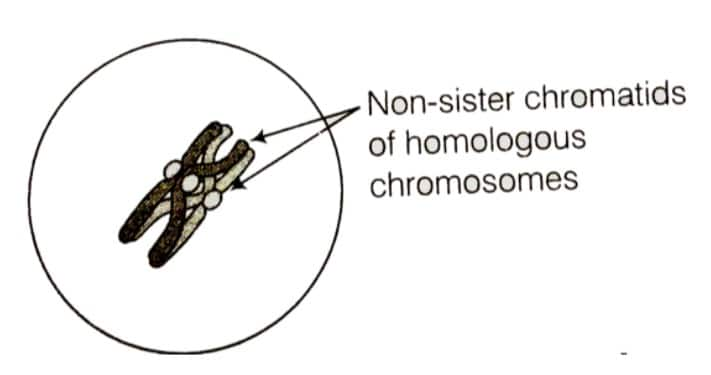
Question:9
Answer:
210 = 1024
The above equation proves that a cell must undergo 10 rounds of mitosis to produce 1024 cells.
Question:10
An anther has 1200 pollen grains. How many pollen mother cells must have been there to produce them?
Answer:
1200 / 4 = 300 (one mother cell produces four daughter cells after the process of meiosis). Therefore, there must be 300 pollen mother cells to produce 1200 pollen grains.
Question:11
At what stage of the cell cycle does DNA synthesis take place?
Answer:
DNA synthesis takes place during the S phase.
Question:12
Answer:
Interphase is the phase of the cycle that occupies the maximum part of the cell cycle.
Question:13
It is observed that heart cells do not exhibit cell division. Such cells do not divide further and exit the _____ phase to enter an inactive stage called _____ of the cell cycle. Fill in the blanks.
Answer:
G₁ phase, G₀ (quiescent) phase.
Question:14
In which phase of meiosis are the following formed? Choose the answers from the hint points given below.
(a) Synaptonemal complex _____
(b) Recombination nodules _____
(c) Appearance/activation of ____ enzyme recombinase
(d) Termination of chiasmata ____
(e) Interkinesis _____
(f) Formation of the dyad of cells _____
Answer:
(a) Zygotene
(b) Pachytene
(c) Pachytene
(d) Diakinesis
(e) After Telophase - I/before Meiosis – II
(f) Telophase I
Find Answers to NCERT Exemplar Class 11 Biology Chapter 10 (Short Answer)
Question:1
State the role of centrioles other than spindle formation.
Answer:
Apart from its role in spindle formation, Centrioles also form the basal body of cilia and flagella. They also aid in the formation of microtubules and sperm tails.
Question:2
Answer:
The DNA in mitochondria and plastids is extra-genomic DNA in nature. They have no correlation with the nuclear division during mitosis. Thus, karyokinesis during cell division has no effect on extra-genomic DNAs.
Question:3
Label the diagram and also determine the stage at which this structure is visible
Answer:
The stage is metaphase during mitosis.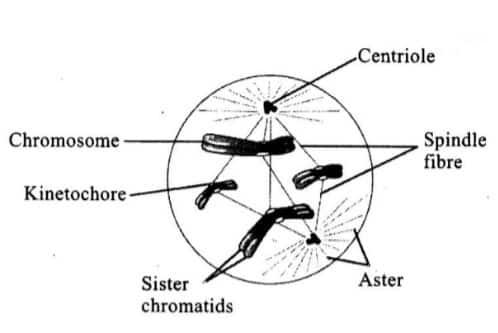
Question:4
Answer:
The number will remain 32 because the number of chromosomes does not change during metaphase or anaphase. DNA replication takes place during the S phase, and hence, the DNA content gets doubled after the S phase; and it will remain so during mitosis.
Question:5
Answer:
The difference in the chromosome numbers can be attributed to Mosaicism. It is the phenomenon that describes the existence of two types of chromosome numbers in different cells of the body. This situation arises due to lagging of anaphase or non-disjunction of chromosomes.
Question:6
The following events occur during the various phases of the cell cycle. Name the phase against each of the events.
(a) Disintegration of the nuclear membrane
(b) Appearance of nucleolus
(c) Division of the centromere
(d) Replication of DNA
Answer:
(a) Prophase
(b) Telophase
(c) Anaphase
(d) S-phase
Question:7
Mitosis results in the production of two cells that are similar to each other. What would be the consequence if each of the following irregularities occurred during mitosis?
(a) Nuclear membrane fails to disintegrate
(b) Duplication of DNA does not occur
(c) Centromeres do not divide
(d) Cytokinesis does not occur.
Answer:
(a) The spindle fibres would not be able to reach chromosomes if the nuclear membrane fails to disintegrate. Because of this, the chromosomes would not be able to reach the opposite poles of the cell.
(b) The cell may not be able to reach the M phase if the DNA duplication does not take place. This shall result in the cessation of the cell cycle.
(c) If the division of centromeres does not take place, then one of the daughter cells will get a complete pair of chromosomes, and another daughter cell will get none. This may result in trisomy.
(d) If cytokinesis does not occur, then a cell with the multinucleate condition would be formed.
Question:8
Answer:
In unicellular organisms, the cells are divided into two parts. In unicellular organisms, mitosis results in asexual reproduction, while in multicellular organisms, mitosis is for growth and repair. The basic mechanism of mitosis remains the same.
Question:9
Name the pathological condition when uncontrolled cell division occurs.
Answer:
Malignancy is a pathological condition in which uncontrolled cell division occurs.
Question:10
Answer:
While the process of the duplication of the centriole takes place in the cytoplasm, the process of DNA replication occurs in the nucleus
Question:11
Answer:
During fertilization, when two haploid cells (gametes) fuse, the formation of a diploid zygote takes place. In the case of the absence of meiosis, the production of two diploid gametes would take place, resulting in the formation of a tetraploid zygote. Meiosis is extremely important to conserve the chromosome number
Question:12
Answer:
The cell that gets arrested in the diplotene stage is the oocyte of mammalian females. It grows and forms a secondary follicle, then subsequently its growth is arrested at the diplotene stage. The first meiosis is completed when the woman gains sexual maturity. The meiosis takes place one by one in the egg that is released from the ovary.
Question:13
How does cytokinesis in plant cells differ from that in animal cells?
Answer:
Animal Cytokinesis | Plant Cytokinesis |
It takes place through cleavage. | It takes place by the cell plate method. |
Soon after anaphase, there is a degeneration of the spindle. | During cytokinesis, the spindle persists. |
The cleavage progresses centripetally. | The growth of the cell plate takes place centrifugally. |
The derivation of the new cell membrane takes place through the endoplasmic reticulum. | The derivation of the new cell membrane is from the vesicles of the Golgi apparatus. |
Get Answers to NCERT Exemplar Class 11 Biology Solutions Chapter 10 (Long Answer)
Question:1
Comment on the statement - Telophase is the reverse of prophase.
Answer:
The following contrasting features between prophase and telophase prove that telophase is the reverse of prophase.
Prophase -
Mitochondria, Golgi Complex, ER, etc., disappear in prophase.
The nuclear membrane starts to fall apart during prophase.
Chromosomes become visible in prophase.
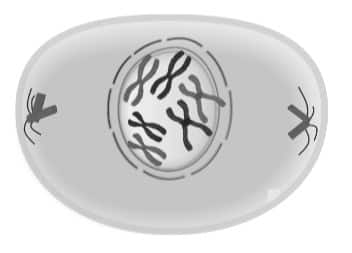
Telophase -
Mitochondria, ER, Golgi Complex, etc. reappear in the telophase.
The nuclear membrane starts to integrate during the telophase.
Chromosomes start to lose their visibility in this telophase.
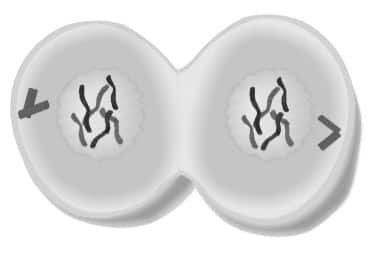
Question:2
Answer:
These are the different stages of meiotic prophase:
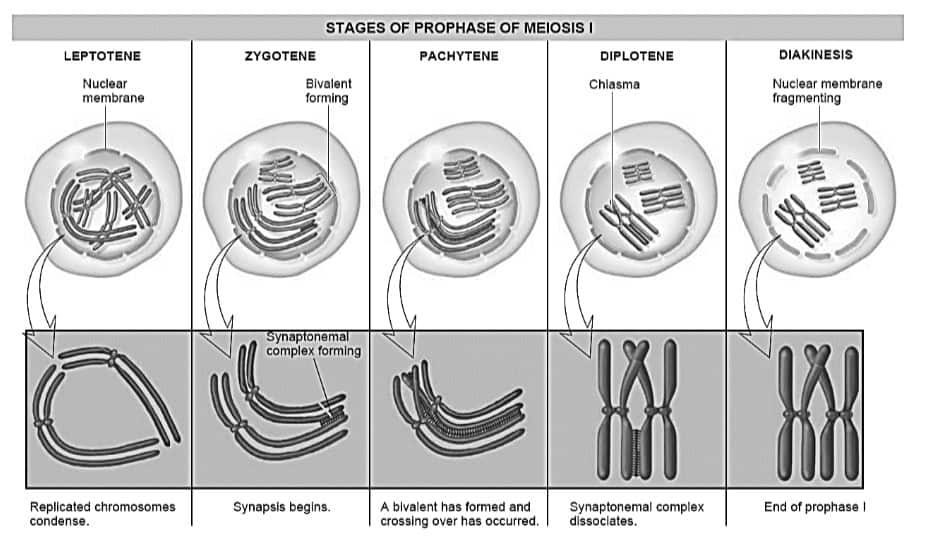
(a) Leptotene: During the stage of leptotene, the chromosomes are slowly visible under a light microscope. The compression of chromosomes continues until the end of this stage. The sister chromatids are tightly bound so that they cannot be differentiated from each other.
(b) Zygotene: Zygotene is the stage where the chromosomes start forming into pairs. This process of formation is called synapsis. The formation of synapses goes along with the formation of synaptonemal complexes. Each pair formed in this process is called a bivalent or tetrad.
(c) Pachytene: In the stage of pachytene, bivalents are fully formed, and crossing over occurs at recombination nodules. Reconnection of the nodules starts to appear on the tetrads. The recombination nodule is the site at which the crossing over of the non-sister chromatid takes place. Crossing over happens between non-sister chromatids of the homologous chromosomes. Crossing over helps in the exchange of genes between two homologous chromosomes.
(d) Diplotene: In the stage of diplotene, the synaptonemal complex starts to break down. The reconnected chromosomes begin to segregate from each other. But they are connected at the site of crossing over. This makes an X-shaped structure called a chiasmata.
(e) Diakinesis: In the Diakinesis stage, the Chiasmata are terminated. The nucleolus disappears in this process, and so does the nuclear membrane.
Question:3
Differentiate between the events of mitosis and meiosis.
Answer:
Events | Mitosis | Meiosis |
Prophase | Prophase is shorter in duration. Chromosomes do not become segregated at this stage. Chromosomes show two distinct chromatids. No crossing over takes place during this stage. Prophase is simple and is not distinguishable into sub-stages. | Prophase I is of longer duration, while prophase II is of shorter duration. Chromosomes are quite distinct. Chromosomes of prophase–I do not show distinct chromatids. Chiasmata are formed, and crossing takes place. |
Metaphase | A single metaphase plate is formed during metaphase. Chromosomes are independent in this phase and do not show connections. The limbs of chromosomes are in different directions. Two chromatids of a chromosome are genetically similar. | The homologous pairs align on one metaphase plate, and chromatids separate on the metaphase II plate. The Homologous chromosomes are interconnected. Limbs of chromosomes point towards the centre. The two chromatids of a chromosome are mostly genetically different. |
Anaphase | The centromere splits along its length to form two centromeres during anaphase. Chromosomes are single-stranded. Similar chromosomes move towards the opposite poles. | During anaphase I, centromeres do not require segregation, but segregation of the centromere takes place during anaphase II. Double-stranded chromosomes are visible in anaphase I, but during anaphase II, single-stranded chromosomes are visible. Dissimilar chromosomes move towards the opposite poles. |
Telophase | Telophase is of longer duration. It produces the interphase nuclei. | Telophase is shorter in the case of meiosis. |
Cytokinesis | Cytokinesis is a process that happens after every mitosis. Two daughter cells are formed at the end of this process. | Cytokinesis does not happen after meiosis I, but it happens after the second stage of meiosis. Four daughter cells are formed at the end of meiosis 2. |
Question:4
Write a brief note on the following
(a) Synaptonemal complex
(b) Metaphase plate
Answer:
(a) The synaptonemal complex consists of protein. It is made between two homologous chromosomes in the process of meiosis. It is the site of matching, synapsis, and recombination. During prophase I of meiosis, the homologous chromosomes get matched through the synaptonemal complex. Through this complex, the exchange of genes takes place. Hence, reconnection or recombination of genetic characters happens through a synaptonemal complex.
(b) The metaphase plate is an imaginary line that is at equal distances from the two centrosome poles. During the process of metaphase, the chromosomes get together at the metaphase plate. The even alignment of chromosomes happens because of the facing kinetochore microtubules.
Question:5
Write briefly about the significance of mitosis and meiosis in multicellular organisms.
Answer:
Significance of Mitosis:
Mitosis facilitates the development of a single-cell zygote into a full-grown organism. It helps the growth of an organism. It helps repair worn-out or damaged tissues. It helps vegetative propagation in flowering plants. It helps regeneration in some animals.
Significance of Meiosis:
Meiosis reduces the chromosome number to a haploid in gametes, ensuring the diploid chromosome number is restored after fertilization. This aids in making sure that the conservation of particular chromosomal numbers in species. Meiosis helps genetic variability in populations. This happens due to crossing over during prophase I.
Question:6
Answer:
The following diagram shows different phases of meiosis II of an organism that has two pairs of chromosomes.
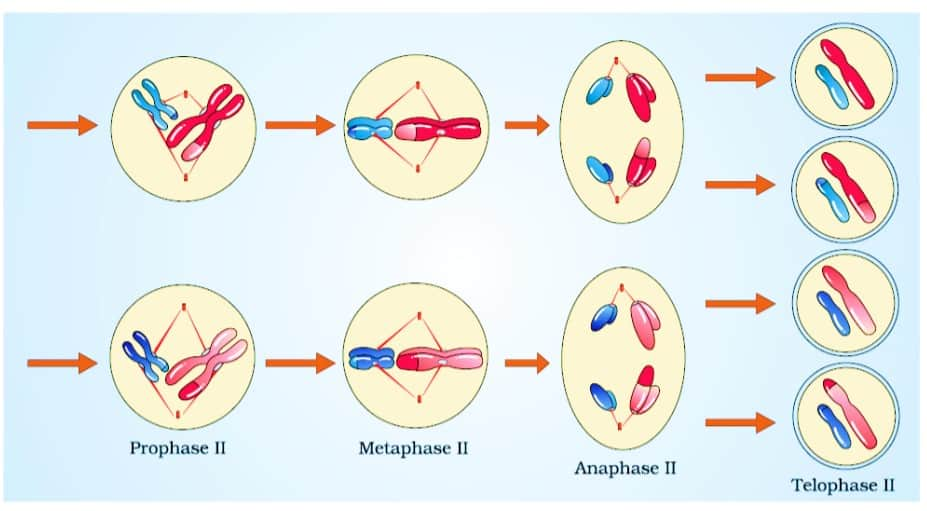
Also, read the NCERT Solution subject-wise
Approach to Solve Cell Cycle and Cell Division Class 11 NCERT Exemplar
This chapter includes a mix of direct, conceptual, and application-based questions. To prepare well:
Read the NCERT and Exemplar thoroughly to understand each phase of the cell cycle, mitosis, and meiosis.
Practice drawing and labelling diagrams of mitosis and meiosis stages.
Memorise the sequence of events in both mitosis and meiosis. Try to understand key terms like cytokinesis, karyokinesis, synapsis, and chiasmata.
Solve all questions given in the Cell Cycle and Cell Division Class 11 NCERT Exemplar.
Revise the importance of cell cycle regulation and checkpoints.
NCERT Exemplar Class 11 Solutions for Other Subjects
- NCERT Exemplar Class 11 Mathematics Solutions
- NCERT Exemplar Class 11 Chemistry Solutions
- NCERT Exemplar Class 11 Physics Solutions
Important topics of NCERT Exemplar Class 11 Biology Solutions Chapter 10
The chapter "Cell Cycle and Cell Division" explores how cells grow, replicate their DNA, and divide to form new cells. NCERT Exemplar Class 11 Biology Chapter 10 covers the phases of the cell cycle, types of cell division, and their significance in growth, repair, and reproduction. Understanding these topics is crucial for exams and foundational biology.
Cell Cycle: Definition & Significance
Phases of the Cell Cycle
Interphase (G₁, S, G₂)
G₀ Phase (Quiescent Stage)
M Phase: Mitosis
Mitosis vs. Meiosis
Meiosis: Stages & Significance
Regulation of the Cell Cycle
Significance of Cell Division
Also Read:
Advantages of NCERT Exemplar Class 11 Biology Chapter 10 Solutions
Cell Cycle and Cell Division chapter is important for students preparing for school exams and competitive exams like NEET, as questions are frequently asked from this chapter. Solving exemplar problems offers many benefits to the students, some of which are mentioned below:
- NCERT Exemplar Class 11 Biology Chapter 10 Solutions provide a clear idea about how cells grow, divide, and undergo stages like interphase and mitosis.
- Practising exemplar solutions improves problem-solving skills and develops accuracy while answering the questions.
- It also allows students to build a strong foundation for higher-level classes and topics such as molecular biology.
- All the answers are explained in a step-by-step manner, which makes it easier for students to understand difficult topics easily without any confusion.
- Students also learn how to write answers in the exams by going through the exemplar problems.
Important Questions of Cell Cycle and Cell Division Class 11 NCERT Exemplar
Cell Cycle and Cell Division is an important chapter for exams, as it covers processes like mitosis, meiosis, and the regulation of cell division. Solving the NCERT Exemplar Class 11 Biology Chapter 10 helps students know about how cells grow, divide, and maintain genetic stability.
Q1. Meiosis in diploid organisms results in:
Option 1. Production of gametes
Option 2. Reduction in the number of chromosomes
Option 3. Introduction of variation
Option 4. All of the above
Answer:
Meiosis in diploid organisms leads to the production of gametes (sex cells), reduces the chromosome number by half to maintain species-specific chromosome number after fertilisation, and introduces genetic variation through processes like crossing over and independent assortment.
Hence, the correct answer is option (4), All of the above.
Question 2. Which of the events listed below is not observed during mitosis?
Option 1. Crossing over
Option 2. Movement of centrioles to opposite poles
Option 3. The appearance of chromosomes with two chromatids joined together at the centromere.
Option 4. Chromatin condensation
Answer :
During prophase I of meiosis, homologous chromosomes exchange genetic material, a process known as crossing over.
Although it does not happen during mitosis, this procedure guarantees genetic variety in gametes.
No genetic material is exchanged during mitosis; instead, it is primarily concerned with the equal division of genetic material to create two daughter cells that are genetically identical.
During mitosis, other processes are seen, including spindle formation, sister chromatid separation, and chromosomal condensation.
Hence, the correct answer is option (1) Crossing over
Question 3. A bivalent of meiosis I consists of
Option 1. Four chromatids and two centromeres
Option 2. Two chromatids and two centromeres
Option 3. Two chromatids and one centromere
Option 4. Four chromatids and four centromeres
Answer :
During meiosis, two homologous chromosomes couple up to produce a bivalent. When two homologous chromosomes pair, a bivalent comprises a total of four chromatids, since each chromosome is made up of two sister chromatids.
A bivalent, on the other hand, has two centromeres rather than four. This is because every chromosome has a single centromere, and the bivalently homologous chromosomes both maintain their own.
Hence, the correct answer is option (1): Four chromatids and two centromeres.
Must Read NCERT Notes subject-wise
NCERT Exemplar Class 11 Biology Solutions Chapter Wise
The NCERT exemplar chapter-wise solutions for class 11 biology are given below-
Frequently Asked Questions (FAQs)
The cyclins and cyclin-dependent kinases (CDKs) regulate the cell cycle to progress through various stages. G1, G2, and M phase checkpoints ensure accurate DNA replication and division. Tumor suppressors such as p53 prevent aberrant growth of cells. Growth factors and DNA damage like internal signals affect regulation.
During the M phase of the cell cycle, the cell goes through mitosis and cytokinesis. Mitosis includes prophase, metaphase, anaphase, and telophase, where the nucleus splits. Cytokinesis comes next, dividing the cytoplasm to create two daughter cells. This is done to distribute genetic material evenly to new cells.
Cytokinesis is crucial in cell division since it provides for the correct separation of cytoplasm, creating two separate daughter cells. It finishes up mitosis or meiosis by separating organelles and cellular components. It provides for cell function and genetic integrity. In the absence of cytokinesis, cells would contain more than one nucleus and impaired function.
During interphase, the cell grows (G₁), replicates its DNA (S phase), and prepares for division by synthesizing RNA and proteins (G₂). Questions related to all these events are included in the NCERT Exemplar Class 11 Biology Solutions Chapter 10 Cell Cycle and Cell Division.
Meiosis results in the production of gametes, reduction in chromosome number, and introduction of genetic variation, which is crucial for maintaining species chromosome number and promoting diversity as explained in the NCERT Exemplar Class 11 Biology Solutions Chapter 10 Cell Cycle and Cell Division.
The cell cycle consists of interphase (G₁, S, and G₂ phases) and the M phase (mitosis or meiosis). The average cell cycle span for a mammalian cell is approximately 24 hours.
Mitosis occurs in somatic cells, resulting in two genetically identical daughter cells with the same chromosome number as the parent. Meiosis occurs in germ cells, producing four genetically diverse gametes with half the chromosome number, introducing variation and enabling sexual reproduction.
If the nuclear membrane fails to disintegrate, spindle fibers cannot access chromosomes. If centromeres do not divide, sister chromatids cannot separate properly, leading to abnormal chromosome distribution. Such errors can result in cell cycle arrest, polyploidy, or diseases like cancer.
Popular Questions
Courses After 12th
Applications for Admissions are open.
As per latest syllabus. Physics formulas, equations, & laws of class 11 & 12th chapters
JEE Main Important Chemistry formulas
Get nowAs per latest syllabus. Chemistry formulas, equations, & laws of class 11 & 12th chapters
JEE Main high scoring chapters and topics
Get nowAs per latest 2024 syllabus. Study 40% syllabus and score upto 100% marks in JEE
JEE Main Important Mathematics Formulas
Get nowAs per latest syllabus. Maths formulas, equations, & theorems of class 11 & 12th chapters

